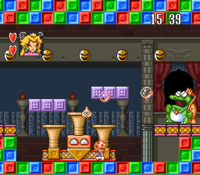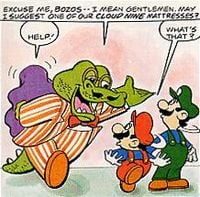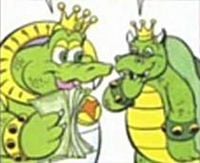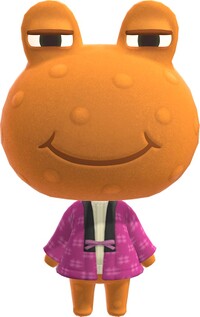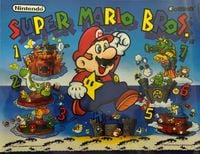Wart: Difference between revisions
Metalex123 (talk | contribs) m (No need for full name since name is on the infobox title) |
|||
| Line 84: | Line 84: | ||
In ''[[Paper Mario: Color Splash]]'', Wart is mentioned by a yellow Toad. Said Toad states that he saw Wart in a dream, only to ponder whether it really was a dream, referencing the events of ''Super Mario Bros. 2''. | In ''[[Paper Mario: Color Splash]]'', Wart is mentioned by a yellow Toad. Said Toad states that he saw Wart in a dream, only to ponder whether it really was a dream, referencing the events of ''Super Mario Bros. 2''. | ||
In the artwork for [[Super Mario Bros. (pinball)]] Wart is shown on the [[castle]] in world 6, despite him not appearing in [[Super Mario World]], the game that the pinball machine is based on. [[File:SMB Pinball-Backglass Artwork Sheet.JPG|thumb|left|Wart left to Mario on the world six castle in ''Super Mario Bros. (pinball)'']] | |||
==Personal information== | ==Personal information== | ||
Revision as of 16:18, September 9, 2018
Template:Character-infobox Template:Quote2
Wart (known in Japan and in The Legend of Zelda: Link's Awakening as Mamu) is the main antagonist of Super Mario Bros. 2. He is the leader of a gang known as the 8 bits and his major appearance centers around his efforts to conquer Subcon, a land of dreams. Wart's information in the game's instruction booklet states, "He is the most mischievous of all in the world of dreams. He created monsters by playing with the dream machine." To attack, Wart can spit streams of bubbles or jets of water.
History
Yume Kōjō: Doki Doki Panic
In Yume Kōjō: Doki Doki Panic, Mamu's true origins lie in the tale of the world of dreams, Muu World. In the original storyline, Mamu had taken control of the Muu people's Dream Machine, producing monsters and mayhem. However, the Muu people knew of his weakness to vegetables and used them to force a surrender, bringing peace back to the dream world.
In the "real" world, the green-dressed monkey Rūsa gives the storybook to the twins Poki & Piki. Towards the end of the book, the twins quarrel and tear out the final page of the story, thus erasing the book's ending. Freed, Mamu pulls through the pages of the storybook and kidnaps the two children. The two kids pleaded for help, and Rūsa hurries away. The family, which consists of Papa and Mama and their son and daughter, Imajin and Lina, jumps through the storybook and embarks on a journey to save the two children and free Muu from Mamu's reign.
One by one, Mamu engages the family in battle in the dream factory. Mamu can spit five bubbles at the four heroes and can destroy the vegetable projectiles produced by the machine of his room. Conventional attack methods are ineffective against the tyrant. The family has to throw vegetables in his mouth when it's open, defeating him after four hits. After Mamu's final defeat, the inhabitants are saved, completing the story. The two kidnapped children are rescued from their cages (with the key being thrown at the cage while Mamu was being beaten offscreen to a pulp by the Muu people) and return with the family back to their world, where the game ends.
Super Mario series
Super Mario Bros. 2
Because the original Super Mario Bros. 2 was considered too difficult for North American audiences, Nintendo remade Doki Doki Panic into a Mario game and released it as Super Mario Bros. 2 outside of Japan. The world of Muu was changed to "Subcon" and Mamu's name was changed to "Wart" for an English-speaking audience. When the International version of Super Mario Bros. 2 was released in Japan as Super Mario USA, the original name of "Mamu" was used for Wart, although the name "Subcon" was retained along with all the plot elements that were changed when the game was originally converted from Doki Doki Panic to a Mario title.
Like in Doki Doki Panic, in Super Mario Bros. 2, Wart uses the hijacked Dream Machine and his army (known as the 8 bits) to conquer Subcon. The plot about the storybook is removed, however, and Wart is simply left undefeated. Instead of fighting him, the natives of Subcon (themselves called Subcons) make contact with Mario through one of his dreams, pleading for him to save them and telling him about Wart's weakness: distaste for vegetables. Mario initially dismisses the message as a regular dream, but the next day he, Luigi, Princess Toadstool, and Toad discover a door to Subcon and decide to save the dream world from Wart.
Mario and his friends proceed to defeat Wart's 8 bits and the leaders, Birdo, Mouser, Fryguy, Clawgrip and Tryclyde. They then confront Wart in the factory, and like the heroes of Doki Doki Panic, use vegetables ejected by the Dream Machine to defeat Wart. In this game, Wart must be forced to swallow six vegetables to be defeated, but other than that, his attacks and abilities are the same as in Doki Doki Panic. After his defeat, Wart is seen one last time during the victory celebrations, being crowd-surfed across the screen by the now-freed Subcons. As he disappears off the screen, swirls and stars appear, implying that they serve him another beat-down for his actions.
After the victory celebrations, Mario wakes up in his bed and is left to ponder if the events that transpired really happened or if they are no more than products of a dream, then continue sleeping.
His role in the Super Mario All-Stars remake was the same, although during the ending sequence, his prone body is seen with what resembled blood underneath his eyes.
Super Mario Advance
In Super Mario Advance, the Game Boy Advance remake of Super Mario Bros. 2, Wart is given dialogue, spoken by Charles Martinet, with Wart's voice bearing resemblance to his performance of Wario. In this game, Wart spoke clear sentences such as, "I am the great Wart!" and "Ah, ribbit!". The 8 bits is also given another major member, Robirdo. One minor difference is that after he is defeated, Wart's body becomes intangible to the player, unlike in the original Super Mario Bros. 2 (and its port in Super Mario All-Stars), wherein the players are dealt damage if they touch his defeated body.
BS Super Mario USA
Wart once again appears in all four "Power Challenge" installments of the Satellaview title BS Super Mario USA, a follow-up of the American version of Super Mario Bros. 2. In this game, it is shown that after his defeat, Wart and his crew escaped to another dream and laid low for a while, eventually returning and attacking Subcon once more, forcing its king into hiding and moving him to summon Mario, Luigi, Toad and Princess Peach once more, thus setting off the events of BS Super Mario USA. This time, Wart also steals the golden statues that had been placed around the land as thanks for Mario's previous rescue.[citation needed]
Wart can be found in every vase in Subspace, where his room is actually identical to that of the final room of the factory (World 7-2) from Super Mario Bros. 2. He possesses the same attacks and is defeated the same way as in his earlier appearances. Like Mouser and Birdo, his portrait will periodically appear on the screen as he casts randomly a spell on Mario. This could be stopped only when Princess Peach aggressively interrupts it. Like all the major characters in this version, he is voiced, though due to its broadcast nature very little of the dialog is known. After his defeat, Subcon vanishes.[citation needed]
Nintendo Comics System
"Cloud Nine"
Wart made an appearance in the Nintendo Comics System issue Cloud Nine. In the comic Wart, disguised as a bed salesman, abducts the Mushroom King and also tries to flood the Mushroom Kingdom. Notably in this story, Mario mentions Wart had abducted the king on at least one previous occasion.
"Duh Stoopid Bomb!"
Wart was also briefly mentioned in a later Nintendo Comics System story entitled Duh Stoopid Bomb!, where his name is seen on Wooster's list of people who think the Mushroom King is dumb.
"Tanooki Suits Me"
Wart eventually reappears in the comics in the story Tanooki Suits Me, in which Bowser plans to sell him pieces of artwork that he had stolen from the Mushroom Castle's Royal Art Gallery for a huge profit. However, a disguised Mario is stolen along with the artwork and, upon discovering Bowser's plot, manages to fool Wart into believing that the artwork is nothing more than worthless droplets of the Apook Corporation. By comparison to Cloud Nine, in this story, Wart bears a better resemblance to his official artwork appearance.
Nintendo Adventure Books
- “Right here in the Land of Outrageous Dreams. It's a most excellent dream, Dude. Far superior to that conquer-the-world stuff. Now I dream of skating the most radical inclines possible. That short fungus doctor dude helped me turn Subcon into this raucous skate park. Gnarly, don't you agree?”
- —Wart, Doors to Doom
Wart made an appearance in the Nintendo Adventure Books book Doors to Doom. Dr. Sporis von Fungenstein had convinced him to convert the denizens of Subcon into surfers, and when the Mario Brothers meet Wart, he is friendly and playing a Game Boy. He tries to trade a garage door opener for one of their hats.
In the later book Dinosaur Dilemma, Wart has a cameo as one of the guests invited to the party Bowser is holding at his Dinosaur Island Castle, in honor of being chosen as the recipient of that year's Snowbell Prize. The text introduces Wart as "the king of the Land of Nightmares".
Club Nintendo
Wart is the protagonist in the Club Nintendo comic "Wart steht unter Strom," in which he plays Game Boy and got involved in a fight with Mario due to him simply throwing the batteries of his Game Boy away. Wart looked just like a smaller version of Bowser in this comic. This may be considered as a mistake, since later appearances of him in the magazine refer to him as Bowser.
The Legend of Zelda: Link's Awakening
Wart made an appearance in the game The Legend of Zelda: Link's Awakening, under his Japanese name, Mamu. He lives in a pond beneath the Signpost Maze on Koholint Island, which, like Subcon, is a dream land. However, unlike in the Mario game, Wart is not an antagonist in Link's Awakening, and actually helps the hero, Link, by teaching him a song on the ocarina, the "Frog's Song of Soul", for which Link pays him 300 Rupees. After teaching Link the song, Wart is not seen again.
Hyrule Warriors/Hyrule Warrior Legends
Although Wart himself does not actually appear, he is referenced as a DLC costume for the character Ganondorf in the Koholint Island DLC set (with his also getting the name "Mamu" like in Link's Awakening). As Ganondorf was the primary villain of the game, his getting the costume was most likely a reference to Wart's more villainous role in Super Mario Bros. 2 (and by extension, Doki Doki Panic).
Other appearances, cameos, and references
Wart was mentioned in Shy Guy's biography in Mario Superstar Baseball, but Wart himself did not appear in the game. He was also referenced in Super Smash Bros. Brawl, in that "Wart" was one of the randomly generated names offered to players. In Super Paper Mario, Francis owns and wants more of a comic named Cyborg Wart, which is named for its protagonist.
Wart, mislabeled as "King Koopa," appears in reels B and C in a Master-view toy released during the run of The Super Mario Bros. Super Show!
A frog villager named Wart Jr. appears in Animal Crossing games, a possible nod to Wart.
In Paper Mario: Color Splash, Wart is mentioned by a yellow Toad. Said Toad states that he saw Wart in a dream, only to ponder whether it really was a dream, referencing the events of Super Mario Bros. 2.
In the artwork for Super Mario Bros. (pinball) Wart is shown on the castle in world 6, despite him not appearing in Super Mario World, the game that the pinball machine is based on.
Personal information
Physical description
Wart is large and green with a big white round belly, a general body shape resembling a frog, a vaguely crocodilian snout filled large white teeth, and large claws on his two-toed feet and four-fingered hands. The Nintendo Comics System depicts him with scales and even a spiked tail (similar to Bowser), giving him a closer resemblance to a crocodile or alligator. He is typically depicted as wearing a blue cape (light brown in Super Mario All-Stars). He also wears a crown, a large pendant on a gold necklace, and gold bracelets.
Personality
Very little of his personality has been revealed beyond the fact that he is bad and is willing to cause mayhem and destruction in order to achieve his goal of ruling Subcon. However, BS Super Mario USA does suggest that he is cunning and patient enough to bide his time between attacks, and the fact that he stole all the Mario statues may indicate a spiteful side to his personality.
Gallery
- For this subject's image gallery, see Gallery:Wart.
Video game appearances
| Title | Description | Release date | System/format |
|---|---|---|---|
| Yume Kōjō: Doki Doki Panic | Boss | 1987 | Disk System |
| Super Mario Bros. 2 | Boss | 1988 | NES |
| The Legend of Zelda: Link's Awakening | Non-playable character (uses Japanese name Mamu) | 1993 | Game Boy |
| Super Mario All-Stars | Boss in Super Mario Bros. 2 remake | 1993 | SNES |
| Super Mario All-Stars + Super Mario World | Boss in Super Mario Bros. 2 remake | 1994 | SNES |
| BS Super Mario USA | Boss | 1996 | Super Famicom (Satellaview) |
| The Legend of Zelda: Link's Awakening DX | Non-playable character (uses Japanese name Mamu) | 1998 | Game Boy Color |
| Super Mario Advance | Boss | 2001 | Game Boy Advance |
| Super Mario All-Stars Limited Edition | Boss in Super Mario Bros 2. remake | 2010 | Wii |
Names in other languages
| Language | Name | Meaning | Notes |
|---|---|---|---|
| Chinese | 沃特[1] Wòtè |
Wart | |
| German | Wart[?] | - | |
| Italian | Wart[?] | - |
References
- ^ From the ending scenes of Super Mario Advance as localized by iQue. Reference: 无敌阿尔宙斯 (August 28, 2013). 神游 超级马力欧2敌人官译. Baidu Tieba. Retrieved February 2, 2017.
